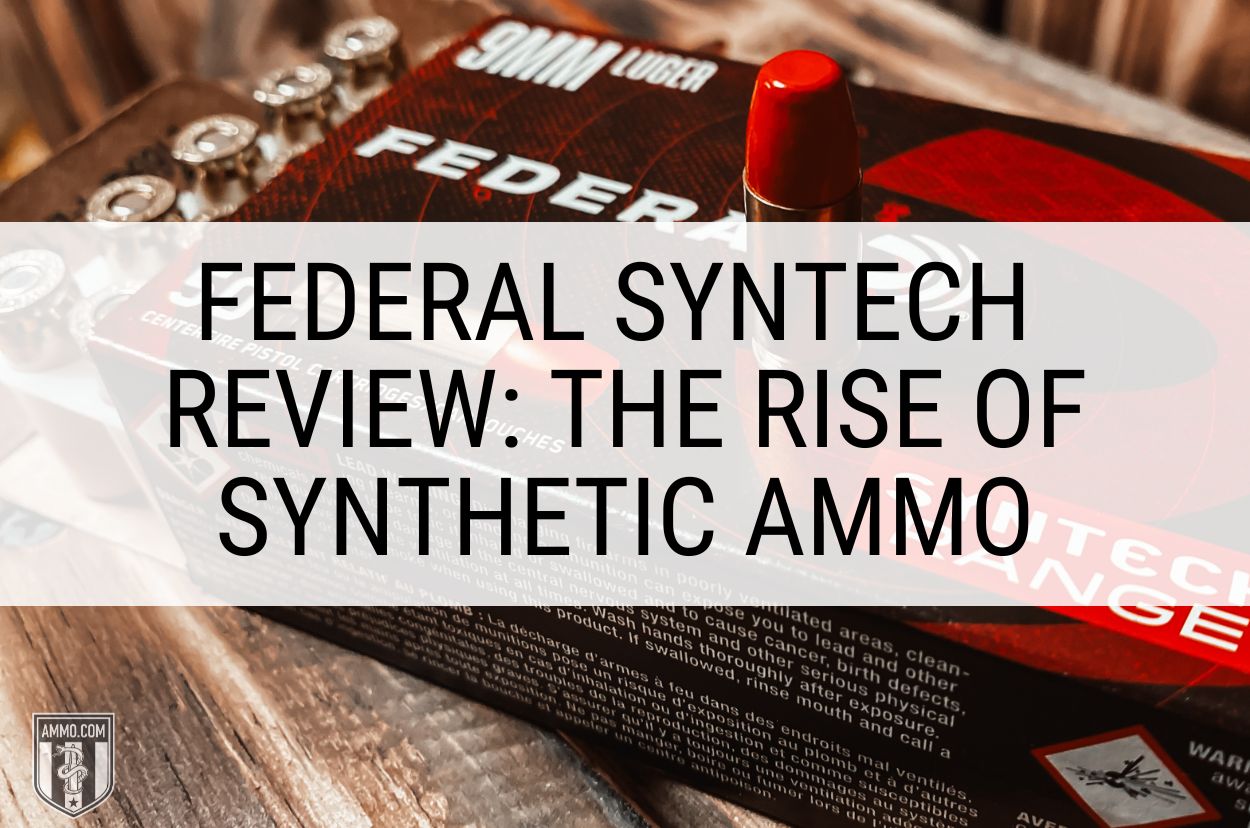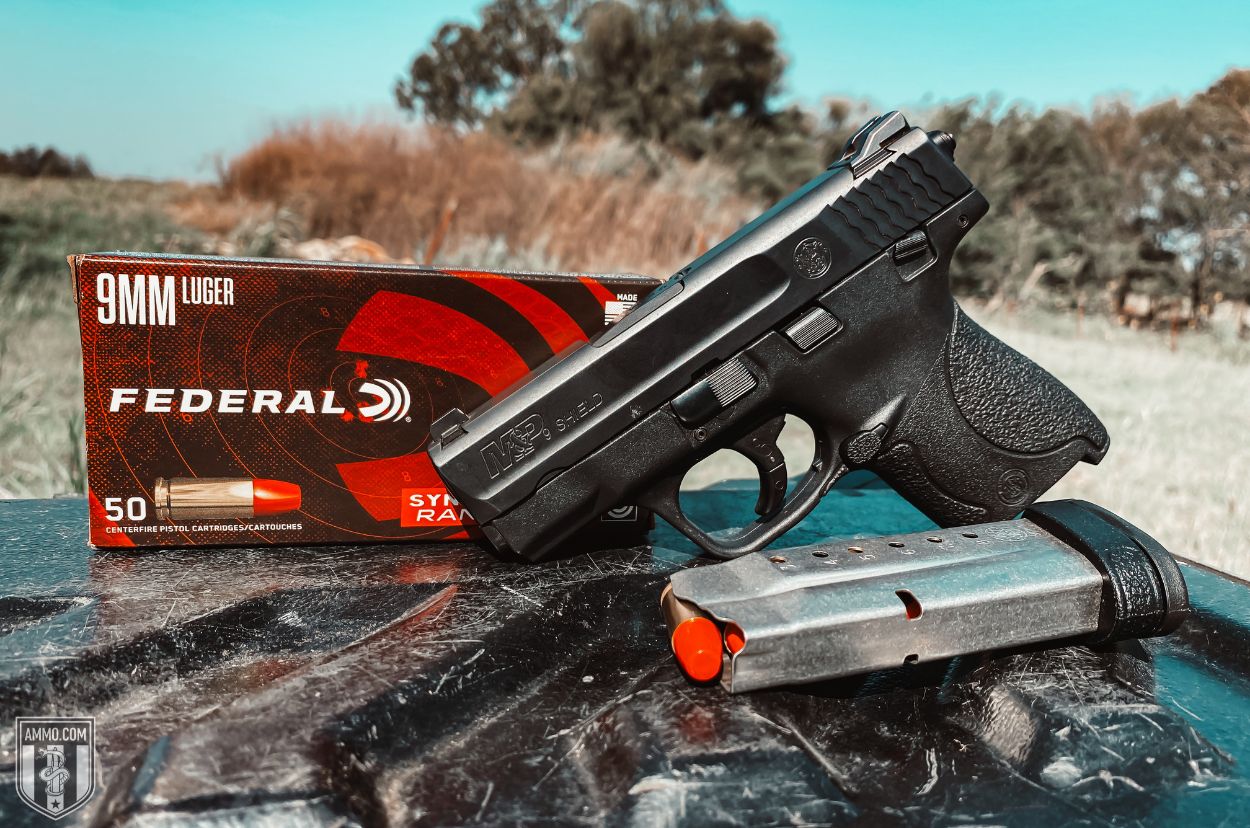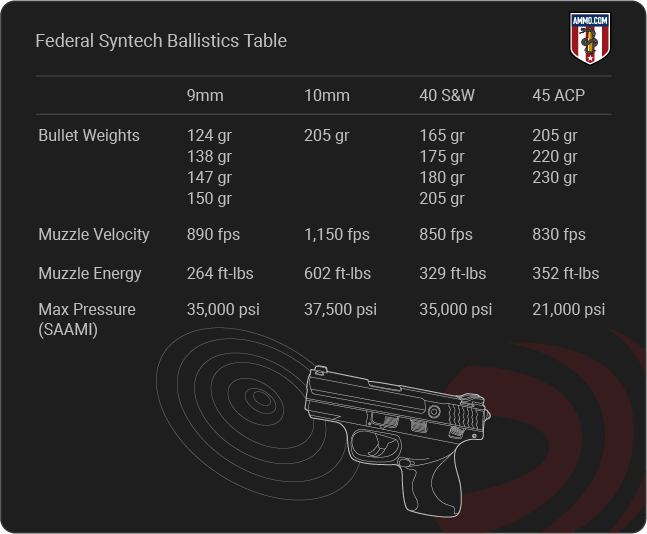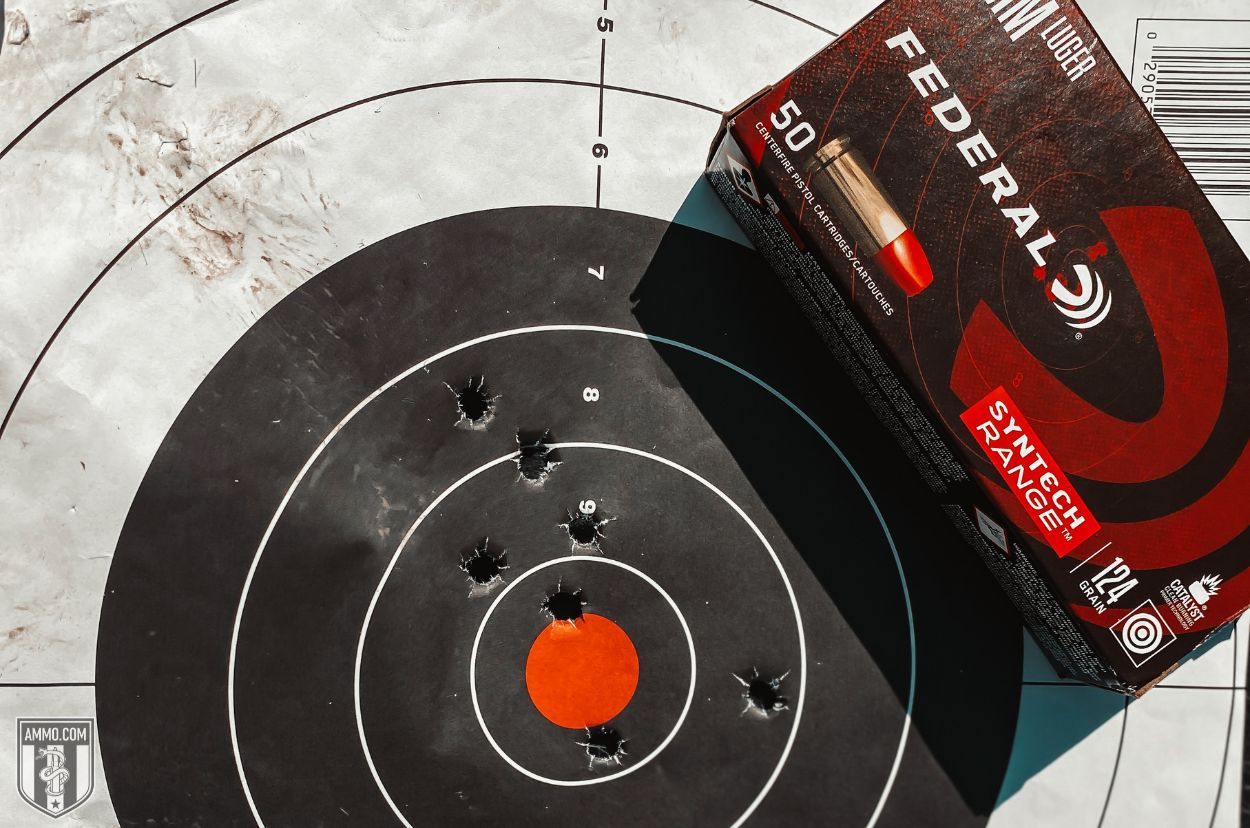Federal Syntech Review: The Rise of Synthetic Ammo

Everything in the world seems to have gone synthetic, which now includes ammo.
Federal Syntech uses a polymer coating called a total synthetic jacket in place of copper-alloy jackets to reduce friction, extend barrel life, and require fewer gun cleaning sessions.
So, is this all a gimmick, or should you grab a few boxes of Federal Syntech ammunition before your next trip to the range?
We're going to find out shortly.
When I found out I would write this Federal Syntech review, I bought ammo to feed my 9mm Luger Smith & Wesson M&P Shield and headed to the gun range.
As you continue reading, you'll discover my findings and opinions, which will help you decide if Syntech ammo is right for you.
Federal Syntech Overview
Federal Premium Ammunition is a world-renowned manufacturer known for producing high-quality rimfire, centerfire, and shotshell ammo.
So, with the release of the Federal Syntech, I had high expectations for these rounds.
The American Eagle Syntech line offers shooters the choice between 9mm, 40 S&W, 45 ACP, and 10mm. Each caliber has various bullet weight and style options.
Federal Ammunition offers most of the calibers mentioned above in Syntech Action Pistol, Syntech Defense, Syntech Training Match, Syntech PCC, and Syntech Range.
Each has its specific purpose for shooting sports, personal defense, or training at the range, which we will discuss further in the Syntech variations section.
What makes this pistol ammunition unique is the total synthetic jacket (TSJ) projectile that has a polymer coating around the lead bullets to reduce metal contact and prevent lead fouling in your barrel. The Catalyst Primer is a lead-free primer that gives shooters reliable ignition of the gunpowder without the use of heavy metals.
These advancements by Syntech loads help make this Federal ammo much safer for indoor shooting, as they eliminate the lead vapors that can harm shooters after many rounds are fired in an enclosed area.
Our Federal Syntech Review

I ordered a box of Syntech Range 9mm Luger 124-grain from Ammo.com, and thanks to the fast shipping, it was at my door within a few days. So I loaded up and headed for the range to run several mags of Syntech loads through my pistol.
I tested the accuracy, which was as good as I expected from a less-than-spectacular shooter like myself, and reliability was on point as well.
I had zero malfunctions, even during rapid-fire, and my pistol looked no dirtier than it was before I began shooting that day.
Federal claims that the Syntech line has less recoil than other loads; however, I didn't notice much of a difference, but I was shooting a 9mm, which isn't known for much recoil anyway.
While purchasing these rounds, I noticed they were much more expensive than traditional full metal jacket (FMJ) lead core bullets from Federal, Remington, Winchester, and many other ammo manufacturers.
That's to be expected with a new and unique technology. As more and more shooters adopt these Syntech Jacket rounds as their go-to range ammo, the price should become more comparable to traditional FMJ bullets.
What Is It Best For?
Federal Syntech ammo is best for those who shoot a lot, like a lot more than I do. If you're concerned with burning through a barrel or tired of cleaning your gun, this is the ammo for you.
It's also great for indoor range shooters because it helps prevent lead vapors and other heavy metals from building up in your body and potentially causing you harm later down the road.
The Syntech Action Pistol ammo with the Syntech jacket flat-nose bullets is the official ammunition of the USPSA. If you're a competitive shooter, these rounds are also great for competitions.
Disadvantages
As with all of our ammo reviews, we pride ourselves on staying as unbiased as possible because we understand no company or product is perfect.
The price is the most significant disadvantage for shooters. This ammo offers firearms enthusiasts a few advantages, but I'm not sure they're worth the price increase, EXCEPT for those who primarily shoot indoors; your health is worth the increase.
Another disadvantage is the small caliber selection. Syntech-jacketed ammo is only available in carbine and pistol calibers, so rimfire and rifle shooters must buy other ammo.
Pros and Cons of Federal Syntech Ammo

Below are the pros and cons I found while researching and testing Federal Syntech ammo.
Pros
- Syntech bullet prevents metal-on-metal contact, eliminating copper and lead fouling and extending barrel life
- Lead-free primer provides reliable and consistent ignition without heavy metals
- Clean-burning propellants minimize residue and fouling, which significantly reduces how often you NEED to clean your firearm
- The absence of a copper jacket minimizes splash-back on steel targets
- Less felt recoil
- Brass casings allow for reloading
Cons
- More expensive than traditional FMJ rounds
- Only available in pistol or carbine calibers
Ballistics of Federal Syntech Bullets
Below, we created a ballistics table for Syntech 9mm, 10mm, 40 S&W, and 45 ACP for you to take a look at.

*I don't own a ballistic chronograph to test some of these numbers for myself, so they were taken from the ammo box and FederalPremium.com. The muzzle velocity and energy are taken from the heaviest bullet weight.
Federal Syntech Variations
As I previously mentioned, there are several types of Federal Syntech ammo. Each has a specific purpose for shooters, which we'll talk about below.
Syntech Action Pistol
Syntech Action Pistol is designed for action shooting sports. So it's loaded to power factor requirements with heavy, flatter-nosed bullets, so you get more reliable knock-downs on steel targets in competition.
It comes in 9mm, 40 S&W, and 45 Auto.
Syntech Defense
Syntech Defense gives you excellent terminal performance with a hollow-point (HP) bullet that separates into three segments and a deep-penetrating core on impact. The bullet core goes 12"-18" into ballistics gel and through heavy clothing, while the petals make three secondary wound channels, only increasing its effectiveness as a self-defense round.
Unlike Federal HST, which uses nickel-plated brass casings, Syntech Defense uses regular brass casings. It comes in 9mm, 40 S&W, and 45 Auto.
Syntech Training Match
Syntech Training Match loads offer the same velocity, trajectory, and point of impact as Federal Premium Personal Defense HST and Tactical HST Duty ammunition, so you can train with ammo that gives you the same results as your field ammo.
It's produced in 9mm, 40 S&W, and 45 Auto.
Syntech PCC

Syntech PCC is designed for carbines. It meets the demands of Pistol Caliber Carbine competitions. Velocity and accuracy are optimized for the longer barrel lengths, with a bullet profile that gives you incredible accuracy and feeds reliably in various carbine platforms.
At the time of writing this ammo is only available in 9mm.
Syntech Range
Syntech Range is intended to be used during a day of fun shooting at the range. It's not competitive or hand-loaded quality ammo, but its ability to reduce metal-on-metal contact and clean burning powder keeps you shooting longer.
It's available in 9mm, 40 S&W, 45 Auto, and 10mm.
Parting Shots: Federal Syntech Ammo Review
Now that you've finished our Federal Syntech Review, you can determine if this ammo fills your needs or if you should continue looking for something else.
While I enjoyed testing it, I'm not sure it's worth the extra cost for me, but I see the excellent benefits for indoor range and competition shooters.
Either way, check out what's in stock at Ammo.com to experience our incredible customer service and blazing-fast shipping.
Frequently Asked Questions
I've taken the liberty to gather and answer some of the commonly asked questions regarding Federal Syntech ammo.
Is the Federal Syntech worth buying?
Yes, Federal Syntech is worth buying if you often shoot at an indoor range. If you don't shoot often or primarily at an outdoor range, you probably don't need Federal Syntech.
What is the range of Federal Syntech?
The range of Federal Syntech is comparable to other rounds of the same caliber. For handgun calibers, it's about 50 yards.
Ammunition Reviews
- Federal Punch Ammo Review
- Magtech 5.56 Ammo Review
- Hornady 6mm ARC Ammo Review
- Hornady LeveRevolution 30-30 Ammo Review
- Hornady Superformance 6.5 Creedmoor Ammo Review
- Hornady Critical Duty 9mm Ammo Review
- Federal 22LR AutoMatch Ammo Review
- Golden Tiger 7.62x39 Ammo Review
- Federal Non-Typical Ammo Review
- CCI Blazer Aluminum 9mm Ammo Review
- Hornady SST Ammo Review
- Aguila Minishells Review
- Federal American Eagle Ammo Review
- Hornady American Whitetail Ammo Review
- Rio Shotgun Shells Review
- Hornady Frontier 5.56 Ammo Review
- Aguila .22LR Ammo Review
- Federal Training Ammo Review
- Hornady Critical Defense 9mm Review
- Federal Hydra-Shok 380 Review
- Wolf Military Classic 7.62x39 Review
- Federal Syntech Review
- Hornady Critical Defense Review
- Hornady SST Muzzleloader Bullets Review
- Federal Hydra Shok 12 Gauge Slug Review
- Hornady American Whitetail 223 Review
- Hornady Black Ammo Review
- Federal Power Shok Ammo Review
- 338 Lapua Ammo Review
- Hornady American Gunner 300 Blackout Ammo Review
- Federal MeatEater Ammo Review
- Blazer Brass 380 Ammo Review
- Blazer 9mm Luger Review
- Hornady LeveRevolution 44 Mag Review
- Federal Independence Ammo Review
- PMC X-TAC 5.56 Ammo Review
- Hornady Superformance 30-06 165gr SST Review
- Federal Champion 9mm Ammo Review
- Blazer Brass 9mm Ammo Review
- Magtech 9mm 124gr Ammo Review
- Magtech 308 Win 168gr HPBT Ammo Review
- Sellier and Bellot 9mm 124gr Ammo Review
- Rifle Line Ammo Review
- Wolf Performance 7.62x39 Ammo Review
- Wolf 6.5 Grendel Ammo Review
- Sellier and Bellot 300 Blackout Subsonic Ammo Review
- Magtech 45 ACP Ammo Review
- Brown Bear 223 Ammo Review
- Hornady Full Boar 223 Ammo Review
- Federal Hydra Shok 9mm Review
- 270 Hornady American Whitetail Review
- Hornady American Whitetail 308 165-Grain Review
- Blazer 9mm 115-Grain Review
- Hornady Black 6.5 Grendel Ammo Review
- Hornady 300 Blackout 190 Gr Sub-X Review
